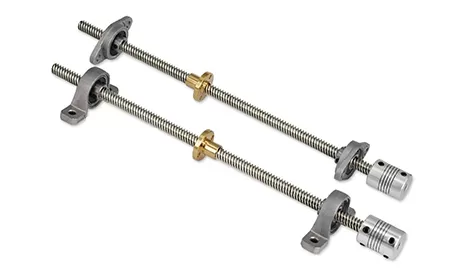
1. Efficiency and Precision:
Ball screws are known for their high efficiency and precision. They feature a recirculating ball mechanism that reduces friction and allows for smooth and efficient motion. This makes them ideal for applications that require high-speed and precise positioning, such as CNC machining, robotics, and automation systems. On the other hand, Trapezoidal screws have a trapezoidal thread design and provide lower efficiency and precision compared to ball screws. They are better suited for applications where cost is a priority and strict precision is not a major requirement.


2. Load Capacity and Rigidity:
When it comes to handling heavy loads and providing rigidity, ball screws outperform Trapezoidal screws. Ball screws have a higher load-carrying capacity due to the ball bearing mechanism, making them suitable for applications that involve heavy loads or require high rigidity, such as industrial machinery and aerospace equipment. Trapezoidal screws, while less capable in terms of load capacity, are still suitable for lighter load applications, making them more cost-effective in certain scenarios.
3. Backlash and Reversibility:
Backlash, or the amount of clearance between the screw and the nut, is an important consideration in motion control systems. Ball screws have minimal backlash due to the rolling ball mechanism, ensuring precise and repeatable positioning. Trapezoidal screws, on the other hand, have more inherent backlash, which can affect the accuracy of the system. Additionally, ball screws offer better reversibility, allowing for smooth and accurate bidirectional motion.
4. Cost and Maintenance:
Trapezoidal screws are generally more cost-effective compared to ball screws, making them a preferred choice in applications where budget constraints are a consideration. They are easier to manufacture and maintain, resulting in lower initial and maintenance costs. Ball screws, although more expensive, offer higher performance and durability, resulting in longer service life and reduced maintenance requirements.

Conclusion:
Choosing between ball screws and Trapezoidal screws depends on your specific application requirements and budget considerations. Ball screws excel in high-speed, high-precision applications where load capacity and rigidity are crucial. Trapezoidal screws are a cost-effective option for applications that do not require strict precision and involve lighter loads. PINSI offers a wide range of high-quality ball screws and Trapezoidal screws, ensuring that you can find the perfect solution for your linear motion needs. Contact us today to explore our product offerings and benefit from our expertise in linear motion systems.


 +8615622924499
+8615622924499
 +8615622924499
+8615622924499

